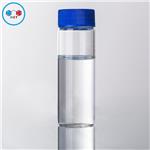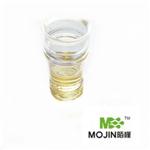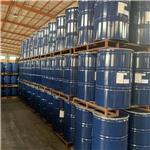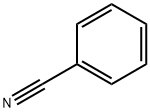- Benzonitrile
-

- $0.00 / 200kg
-
2023-12-18
- CAS:100-47-0
- Min. Order: 200kg
- Purity: 99.75
- Supply Ability: 99999
- Benzonitrile
-

- $0.00 / 25KG
-
2023-09-14
- CAS:100-47-0
- Min. Order: 1KG
- Purity: 99%
- Supply Ability: 50000KG/month
- Benzonitrile
-

- $1.50 / 1g
-
2023-07-27
- CAS:100-47-0
- Min. Order: 1g
- Purity: 99.0% Min
- Supply Ability: 100 Tons
Related articles - What is Benzonitrile?
- Benzonitrile is the chemical compound with the formula C6H5(CN), abbreviated PhCN. This aromatic organic compound is a colorle....
- Aug 11,2020
|
| | Benzonitrile Basic information |
| Product Name: | Benzonitrile | | Synonyms: | PHENYLMETHANITRILE;Benzoitrile;BENZONITRILE, 99.9%, HPLC GRADE;BENZONITRILE, REAGENTPLUS, 99%;BENZONITRILE OEKANAL, 250 ML;BENZONITRILE, ANHYDROUS, 99+%;Benzonitrile, extra pure, 99%;Benzonitrile, for spectroscopy, 99+% | | CAS: | 100-47-0 | | MF: | C7H5N | | MW: | 103.12 | | EINECS: | 202-855-7 | | Product Categories: | Organics;Sure/Seal Bottles;ACS and Reagent Grade Solvents;Carbon Steel Cans with NPT Threads;ReagentPlus;ReagentPlus Solvent Grade Products;Semi-Bulk Solvents;Solvent Bottles;Solvent by Application;Solvent Packaging Options;Solvents;Anhydrous Solvents;Intermediates;Industrial/Fine Chemicals | | Mol File: | 100-47-0.mol |  |
| | Benzonitrile Chemical Properties |
| Melting point | -13 °C (lit.) | | Boiling point | 191 °C (lit.) | | density | 1.01 | | vapor density | 3.6 (vs air) | | vapor pressure | 1 hPa at 20 °C | | refractive index | n20/D 1.528(lit.) | | Fp | 161 °F | | storage temp. | Store below +30°C. | | solubility | 10g/l | | form | Liquid | | color | Clear colorless to slightly yellow | | Relative polarity | 0.333 | | Odor | Almond-like. | | explosive limit | 1.4-7.2%(V) | | Water Solubility | 10 g/L (100 ºC) | | λmax | λ: 300 nm Amax: 1.0
λ: 310 nm Amax: 0.40
λ: 335 nm Amax: 0.03
λ: 360-400 nm Amax: 0.01 | | Merck | 14,1097 | | BRN | 506893 | | Exposure limits | NIOSH: IDLH 14 ppm(25 mg/m3) | | Dielectric constant | 26.0(20℃) | | Stability: | Stable. Incompatible with strong bases, strong acids, strong oxidizing agents, strong reducing agents. Air-sensitive. Combustible. | | InChIKey | JFDZBHWFFUWGJE-UHFFFAOYSA-N | | LogP | 1.5 at 20℃ | | CAS DataBase Reference | 100-47-0(CAS DataBase Reference) | | NIST Chemistry Reference | Benzonitrile(100-47-0) | | EPA Substance Registry System | Benzonitrile (100-47-0) |
| Hazard Codes | Xn | | Risk Statements | 21/22-38 | | Safety Statements | 23 | | RIDADR | UN 2224 6.1/PG 2 | | WGK Germany | 2 | | RTECS | DI2450000 | | Autoignition Temperature | 550 °C | | TSCA | Yes | | HazardClass | 6.1 | | PackingGroup | II | | HS Code | 29269090 | | Hazardous Substances Data | 100-47-0(Hazardous Substances Data) | | Toxicity | LDLo orl-rat: 720 mg/kg AMRL** TR-74-78,74 | | IDLA | 14 ppm (66 mg/m3) |
| | Benzonitrile Usage And Synthesis |
| Description | Benzonitrile is a colorless, oily liquid. It hasan almond odor. Molecular weight = 103.13. Boilingpoint = 191℃; Freezing/Melting point = - 13�℃; Criticaltemperature= 426℃; Critical pressure = 611 psia; Specificgravity (H2O:1) = 1.01 at 25℃; Relative vapor density(air=1) =3.6; Electrical conductivity =2 3 106 pS/m;Ratio of specific heats of vapor (gas) = 1.091; Latentheat of vaporization = 3.67 3 105 J/kg; Heat ofcombustion =-351 3 105 J/kg. Explosive limits in air:Lower= 1.4%, Upper = 7.2%; Flash point = 71℃;Autoignition temperature = 550℃. Hazard Identification(based on NFPA-704 M Rating System): Health 2,Flammability 1, Reactivity 0. Poor solubility in water. | | Chemical Properties | Bezonitrile is a colorless, oily liquid. It has a almond odor and a bitter taste. Slightly soluble in cold water, the solubility in water at 100°C is 1%; miscible with common organic solvents. When heated to decomposition, benzonitrile emits toxic hydrogen cyanide and oxides of nitrogen (HSDB 1988). | | Occurrence | Benzonitrile is reported to be found in natural cocoa aroma), in milk products, roasted filberts and peanuts and cooked trassi . Benzonitrile also has been detected in the thermal decomposition
products of flexible polyurethane foam. | | Uses | The most important commercial use for benzonitrile is the synthesis of benzoguanamine, which is a derivative of melamine and is used in protective coatings and molding resins. It is used intermediate for rubber chemicals; solvent for nitrile rubber, specialty lacquers, and many resins and polymers, and for many anhydrous metallic salts. | | Application | Benzonitrile is a widely utilized as a solvent and an intermediate in industries making drugs, perfumes, dyes, rubber, textiles, resins and specialty lacquers. It finds application as a versatile precursor for many derivatives. It coordinates with transition metal to form complexes which act as synthetic intermediates. | | Preparation | Benzonitrile can be prepared by following methods:
1) on a small scale by the dehydration in an inert solvent with phosphorus oxychloride or benzenesulfonyl chloride and an organic amine.
2) from benzoic acid by heating with lead thiocyanate.
3) by heating sodium benzenesulfonate with sodium cyanide.
4) by adding benzenediazonium chloride solution to a hot aq sodium cyanide solution containing cupric sulfate and distilling by ammoxidation of toluene.
Benzonitrile can also be produced in high yield by the vapor-phase catalytic ammoxidation of toluene. | | Definition | ChEBI: Benzonitrile is a nitrile that is hydrogen cyanide in which the hydrogen has been replaced by a phenyl group. It is a member of benzenes and a nitrile. | | Synthesis Reference(s) | Chemistry Letters, 13, p. 1913, 1984
Journal of the American Chemical Society, 111, p. 4903, 1989 DOI: 10.1021/ja00195a050
Tetrahedron Letters, 11, p. 2085, 1970 | | General Description | Benzonitrile appears as a clear colorless liquid with an almond-like odor. Flash point 161°F. Denser (at 8.4 lb / gal) than water and slightly soluble in water. Used as a specialty solvent and to make other chemicals. | | Air & Water Reactions | Slightly soluble in water. | | Reactivity Profile | The cyano group can be readily hydrolyzed in the presence of mineral acids to produce stable, moderately toxic benzoic acid . When heated to decomposition, Benzonitrile emits highly toxic fumes of nitrogen oxides and hydrogen cyanide [Sax, 9th ed., 1996, p. 353]. | | Hazard | High toxicity; absorbed by skin. | | Health Hazard | Benzonitrile may enter the human body by ingestion, absorption through the skin, or inhalation. The earliest symptoms of cyano compound intoxication may be weakness, headaches, confusion, and occasionally nausea and vomiting. The respiratory rate and depth will usually be increased at the beginning and at later stages become slow and gasping. Blood pressure is usually normal, especially in the mild or moderately severe cases, although the pulse rate is usually more rapid than normal. | | Fire Hazard | Special Hazards of Combustion Products: Toxic hydrogen cyanide and oxides of nitrogen may form in fire. | | Industrial uses | Benzonitrile is used as an intermediate for rubber chemicals and as a solvent for
nitrile rubber, specialty lacquers, many resins, polymers and for many anhydrous
metallic salts (HSDB 1988; Hawley 1981). It is principally used as an intermediate
for benzoguanamine (HSDB 1988). It is also used as an additive in nickel-plating
baths, separating naphthalene and alkylnaphthalenes from non-aromatics by
azetropic distillation; as jet-fuel additive; in cotton bleaching baths; as a drying
additive for acrylic fibers; and in the removal of titanium tetrachloride and
vanadium oxychloride from silicon tetrachloride (HSDB 1988; Smiley 1981).
Benzonitrile is also used in perfumes at a maximum level of 0.2% in the final
product (Opdyke 1979). | | Safety Profile | Poison by intraperitoneal andsubcutaneous routes. Moderately toxic by ingestion,inhalation, and skin contact. A skinirritant. Combustible liquid. When heated todecomposition it emits toxic fumes of CN- and NOx. | | Potential Exposure | Mutagen,Primary Irritant. Benzonitrile is used as an electroplatingagent; in organic synthesis of pharmaceuticals; dyestuffs;rubber chemicals; as a solvent and chemical intermediate.Incompatibilities: Strong acids which can liberate hydrogencyanide. Forms explosive mixture with air. | | First aid | If this chemical gets into the eyes, remove anycontact lenses at once and irrigate immediately for at least15 min, occasionally lifting upper and lower lids. Seek medical attention immediately. If this chemical contacts theskin, remove contaminated clothing and wash immediatelywith soap and water. Seek medical attention immediately. Ifthis chemical has been inhaled, remove from exposure,begin rescue breathing (using universal precautions, including resuscitation mask) if breathing has stopped and CPR ifheart action has stopped. Transfer promptly to a medicalfacility. When this chemical has been swallowed, rinsemouth and get medical attention. If cyanide poisoning issuspected use amyl nitrate capsules if symptoms develop.All area employees should be trained regularly in emergency measures for cyanide poisoning and in CPR. A cyanide antidote kit should be kept in the immediate work areaand must be rapidly available. Kit ingredients should bereplaced every 1� 2 years to ensure freshness. Personstrained in the use of this kit, oxygen use, and CPR must bequickly available. | | Metabolism | Benzonitrile is mainly hydroxylated in vivo to cyanophenols, a small amount being
hydrolysed to benzoic acid (Williams 1959). Benzonitrile also forms 6>-hydroxybenzonitrile,
m-hydroxybenzonitrile, and /p-hydroxybenzonitrile in rabbits (HSDB
1988). In rabbit, 50% of a dose of 150 mg/kg was converted to conjugated
cyanophenols and 10% of the benzonitrile fed was excreted as benzoic acid.
Hydrogen cyanide is not a metabolite of benzonitrile (Williams 1959) and cyanide
was not found to be formed by benzonitrile either in vivo or in vitro (Tanii and
Hashimoto 1984). The in vivo microsomal hydroxylation of specifically deuterated
benzonitrile in the rat yielded mainly 4-hydroxybenzonitrile with 41%
retention of deuterium (Daly et al 1968). | | storage | Color Code—Blue: Health Hazard/Poison: Storein a secure poison location. Store in tightly closed containers in a cool, well-ventilated area. Away from strong acids.Metal containers involving the transfer of this chemicalshould be grounded and bonded. Drums must be equippedwith self-closing valves, pressure vacuum bungs, and flamearresters. Use only nonsparking tools and equipment, especially when opening and closing containers of this chemical. Sources of ignition, such as smoking and open flames,are prohibited where this chemical is used, handled, orstored in a manner that could create a potential fire orexplosion hazard. | | Shipping | UN2224 Benzonitrile, Hazard Class: 6.1; Labels:
6.1—Poisonous materials. | | Purification Methods | Dry benzonitrile with CaSO4, CaCl2, MgSO4 or K2CO3, and distil it from P2O5 in an all-glass apparatus, under reduced pressure (b 69o/10mm), collecting the middle fraction. Distillation from CaH2 causes some decomposition of benzonitrile. Isonitriles can be removed by preliminary treatment with conc HCl until the odour of isonitrile (carbylamine) has gone, followed by preliminary drying with K2CO3. (This treatment also removes amines.) Steam distil (to remove small quantities of carbylamine). The distillate is extracted into ether, washed with dilute Na2CO3, dried overnight with CaCl2, and the ether is removed by evaporation. The residue is distilled at 40mm (b 96o) [Kice et al. J Am Chem Soc 82 834 1960]. Conductivity grade benzonitrile (specific conductance 2 x 10-8 mho) is obtained by treatment with anhydrous AlCl3, followed by rapid distillation at 40-50o under vacuum. After washing with alkali and drying with CaCl2, the distillate is redistilled in a vacuum several times at 35o before fractionally crystallising several times by partial freezing. It is dried over finely divided activated alumina from which it is withdrawn when required [Van Dyke & Harrison J Am Chem Soc 73 402 1951]. [Beilstein 9 IV 892.] | | Incompatibilities | Incompatible with oxidizers (chlorates, nitrates, peroxides, permanganates, perchlorates, chlorine, bromine, fluorine, etc.); contact may cause fires or explosions. Keep away from alkaline materials, strong bases, strong acids, oxoacids, epoxides. They are incompatible Benzonitrile with acids; mixing nitriles with strong oxidizing acids can lead to extremely violent reactions. | | Waste Disposal | (1) Mix with calcium hypochlorite
and flush to sewer with water or (2) incinerate. |
| | Benzonitrile Preparation Products And Raw materials |
|